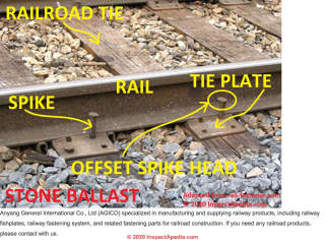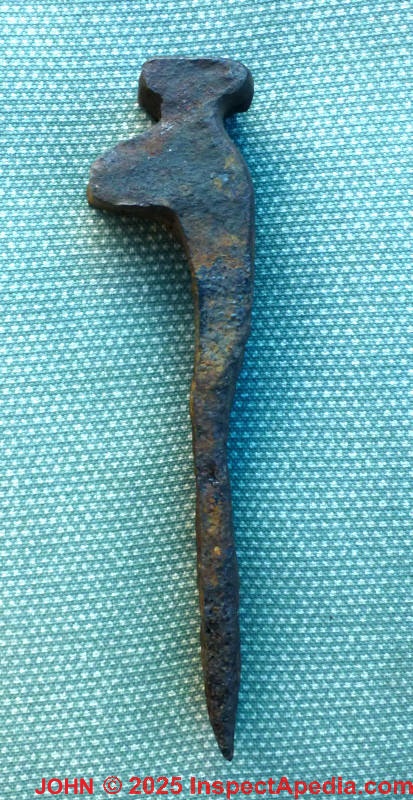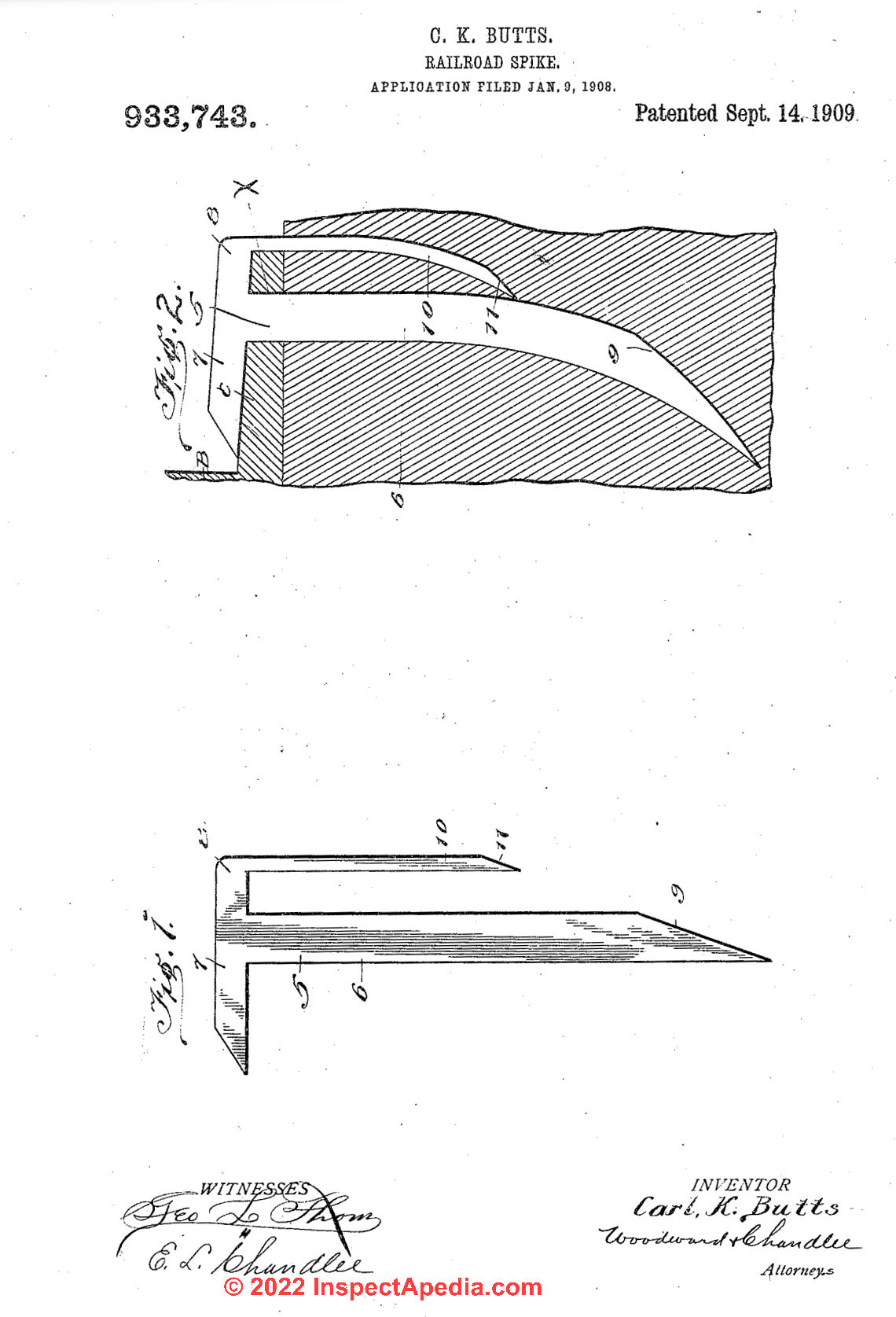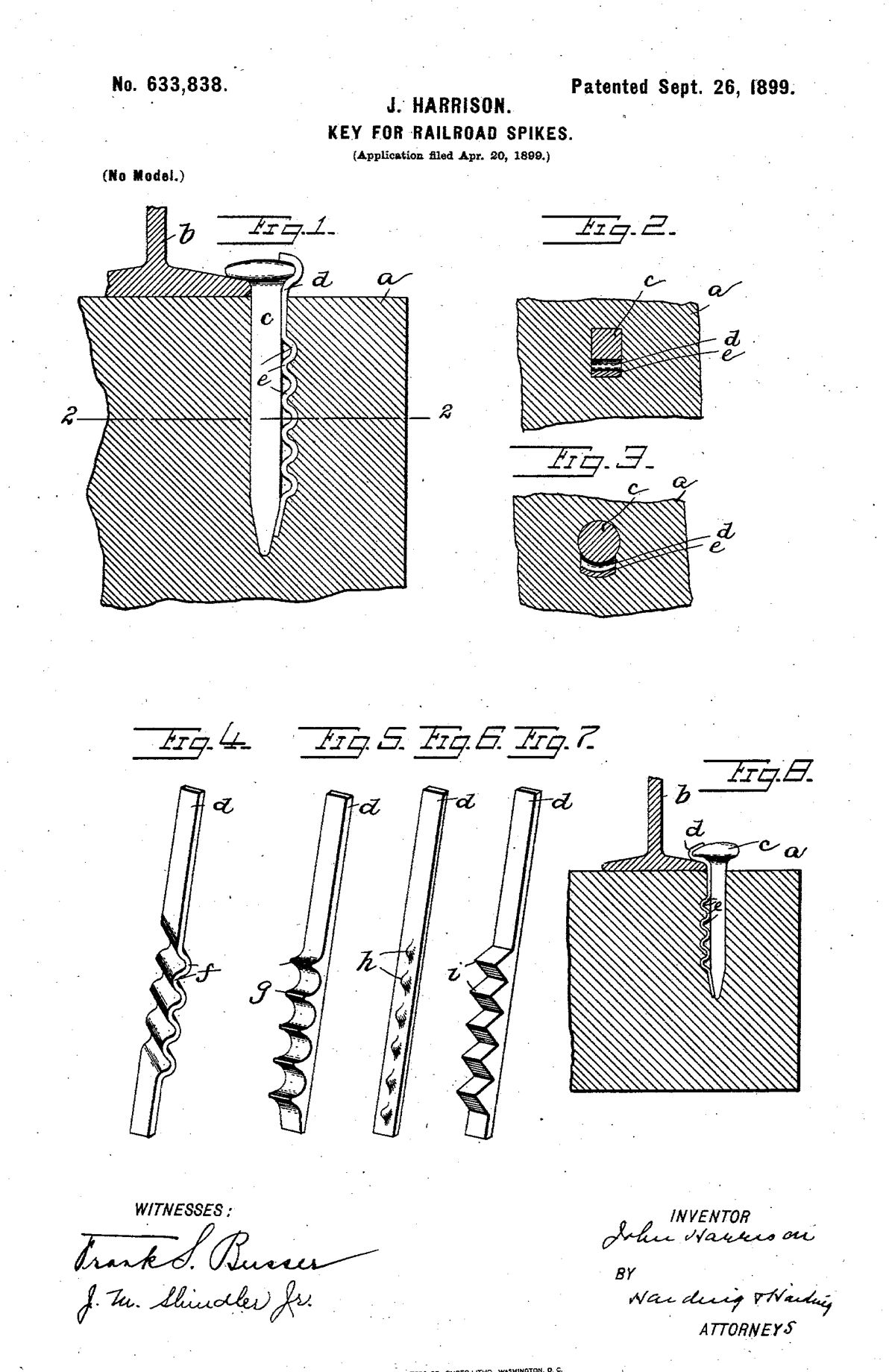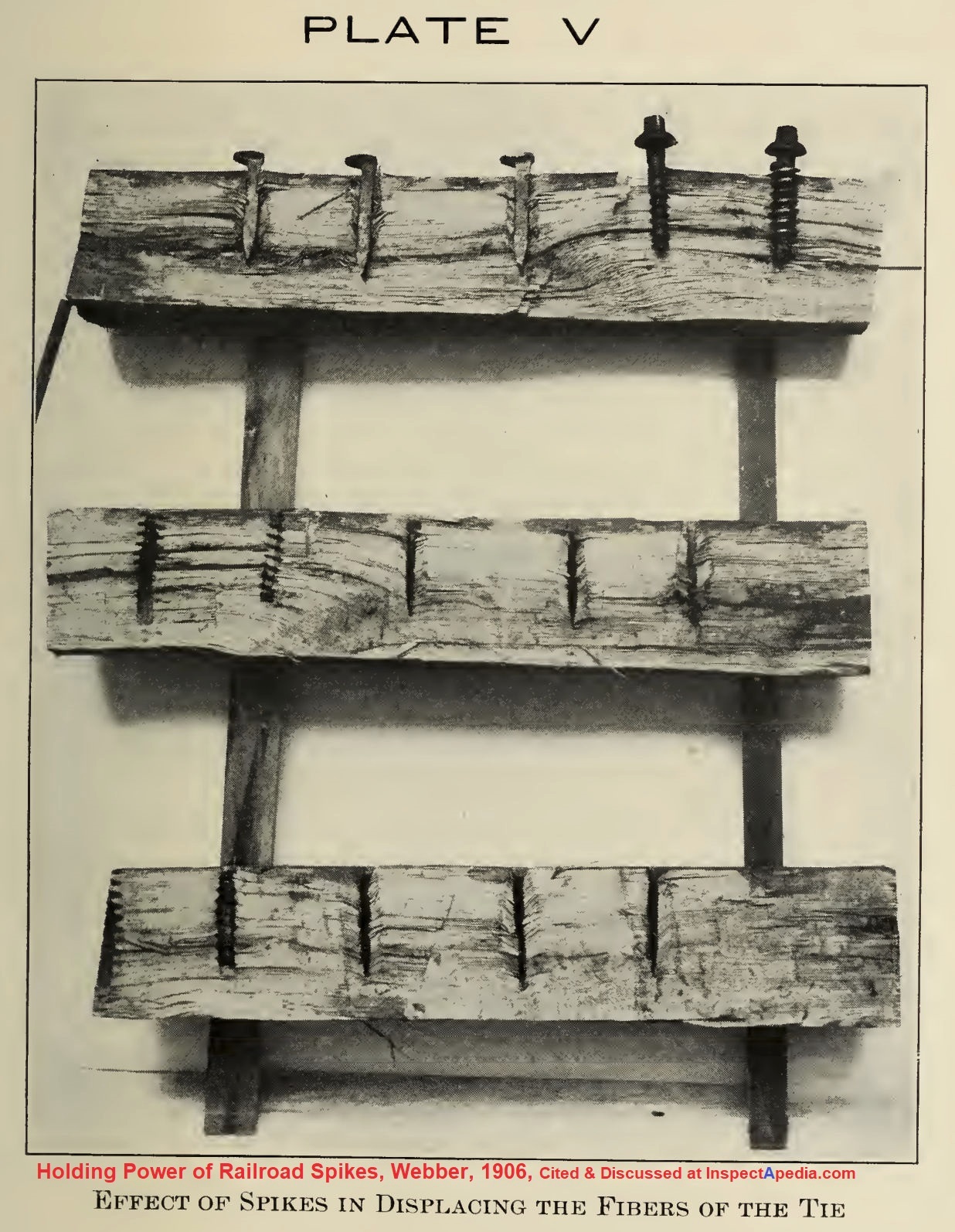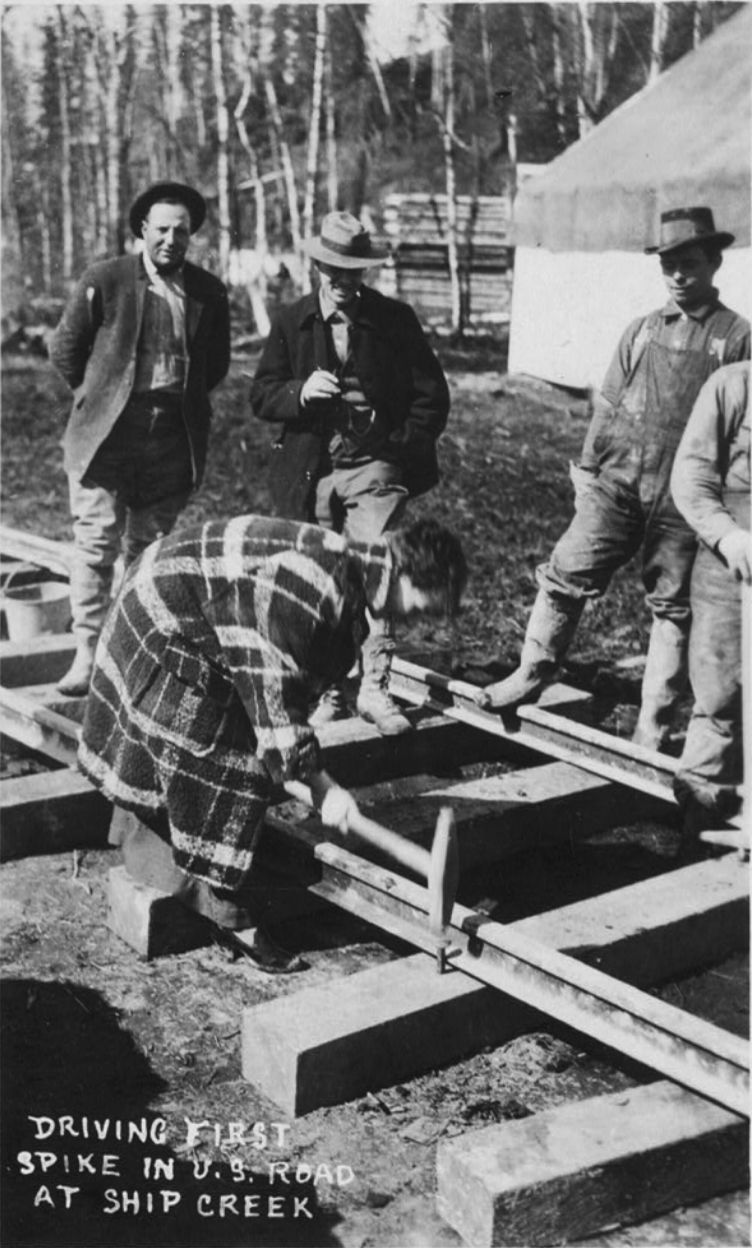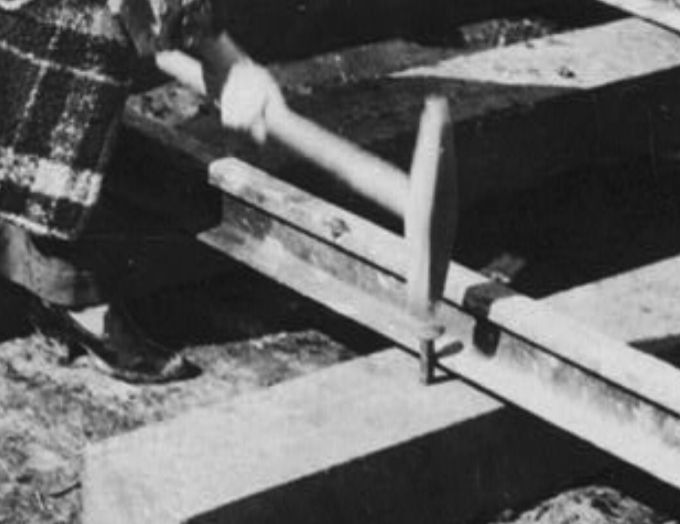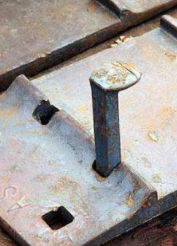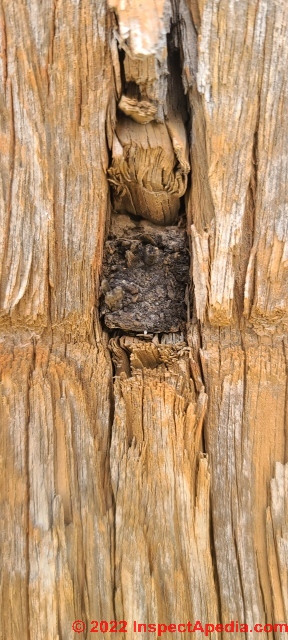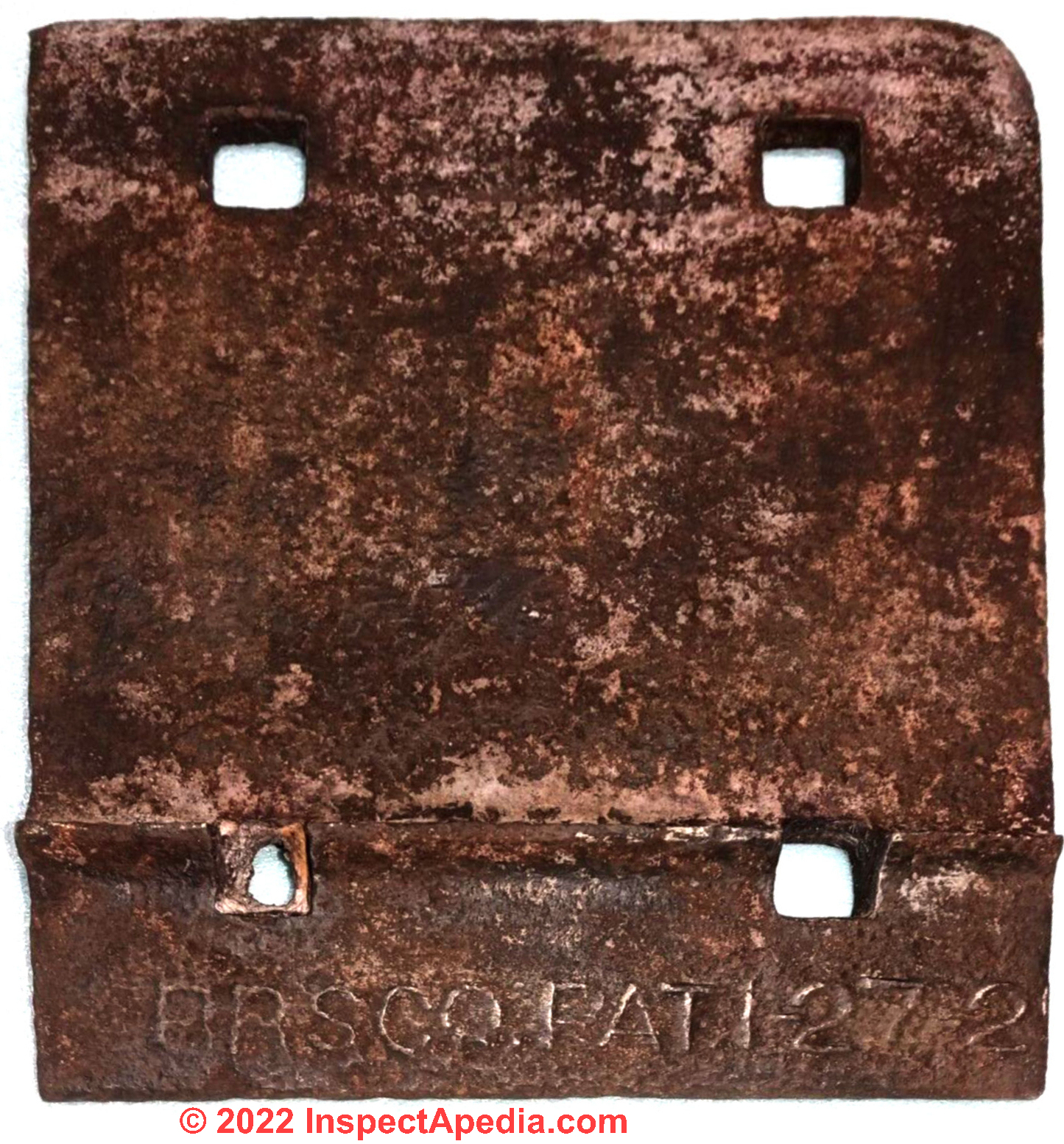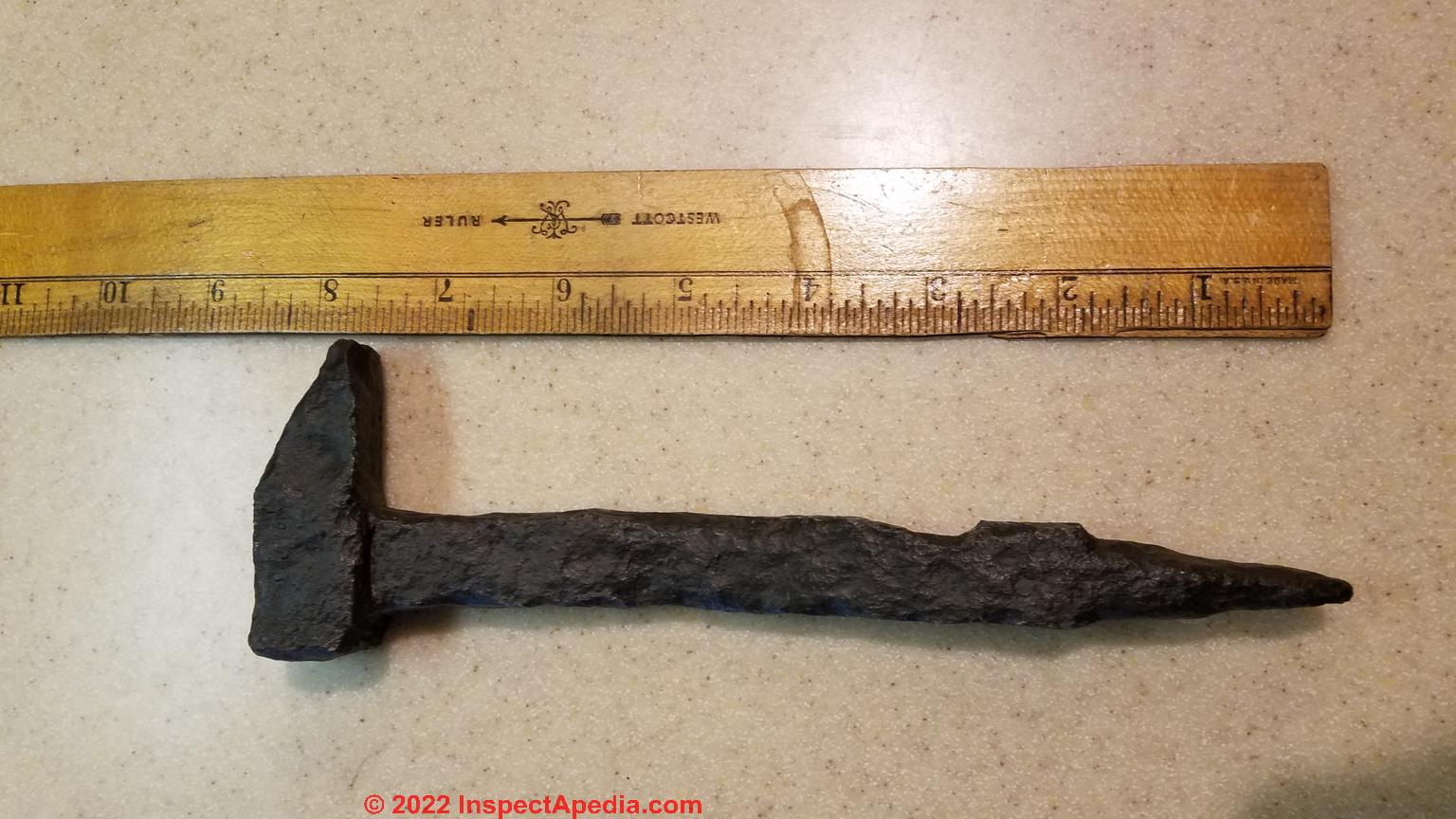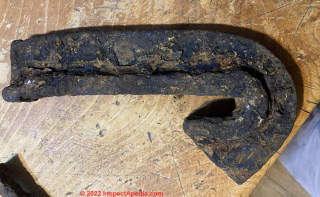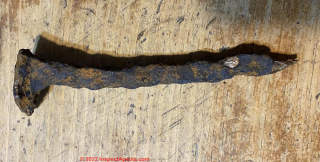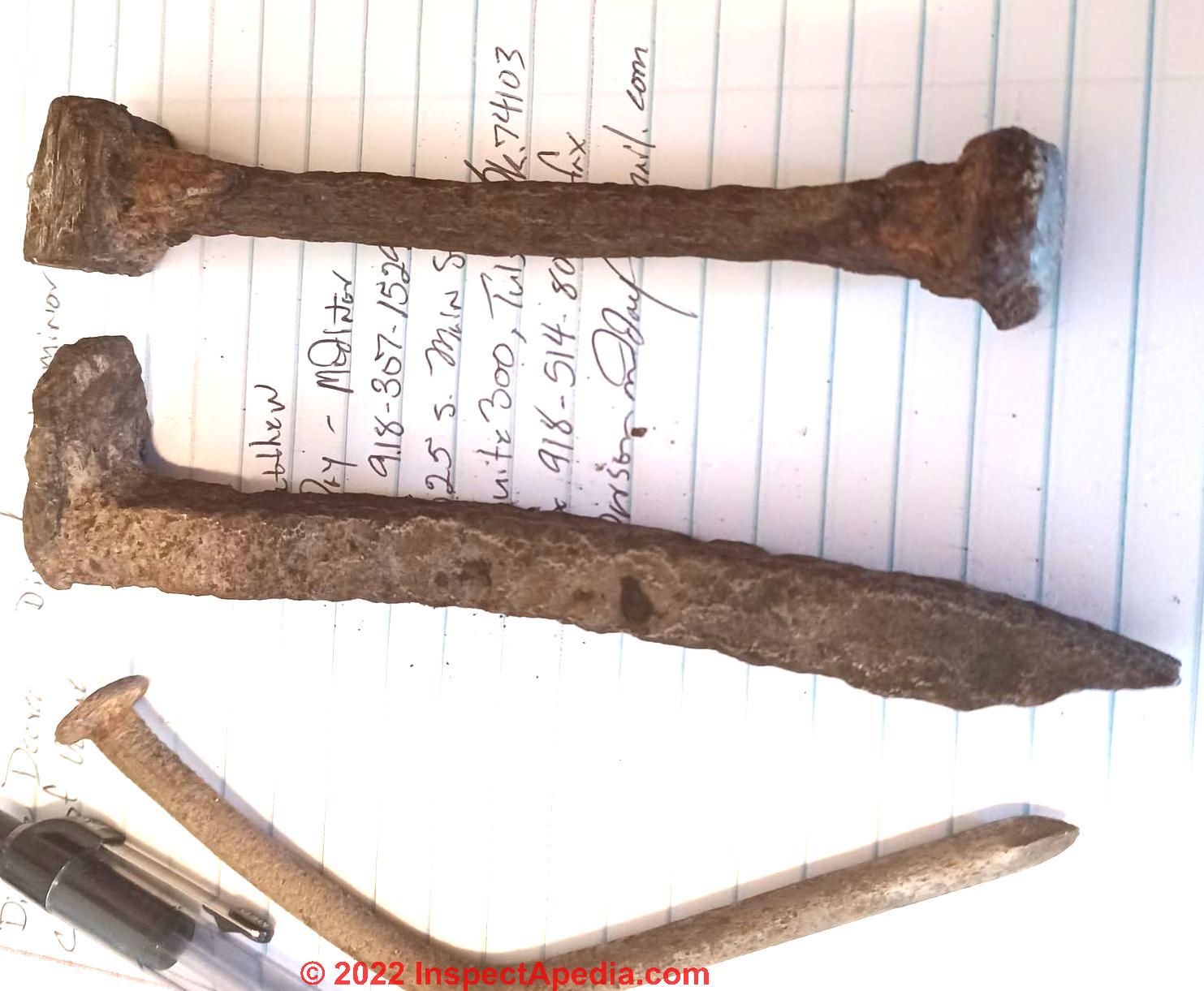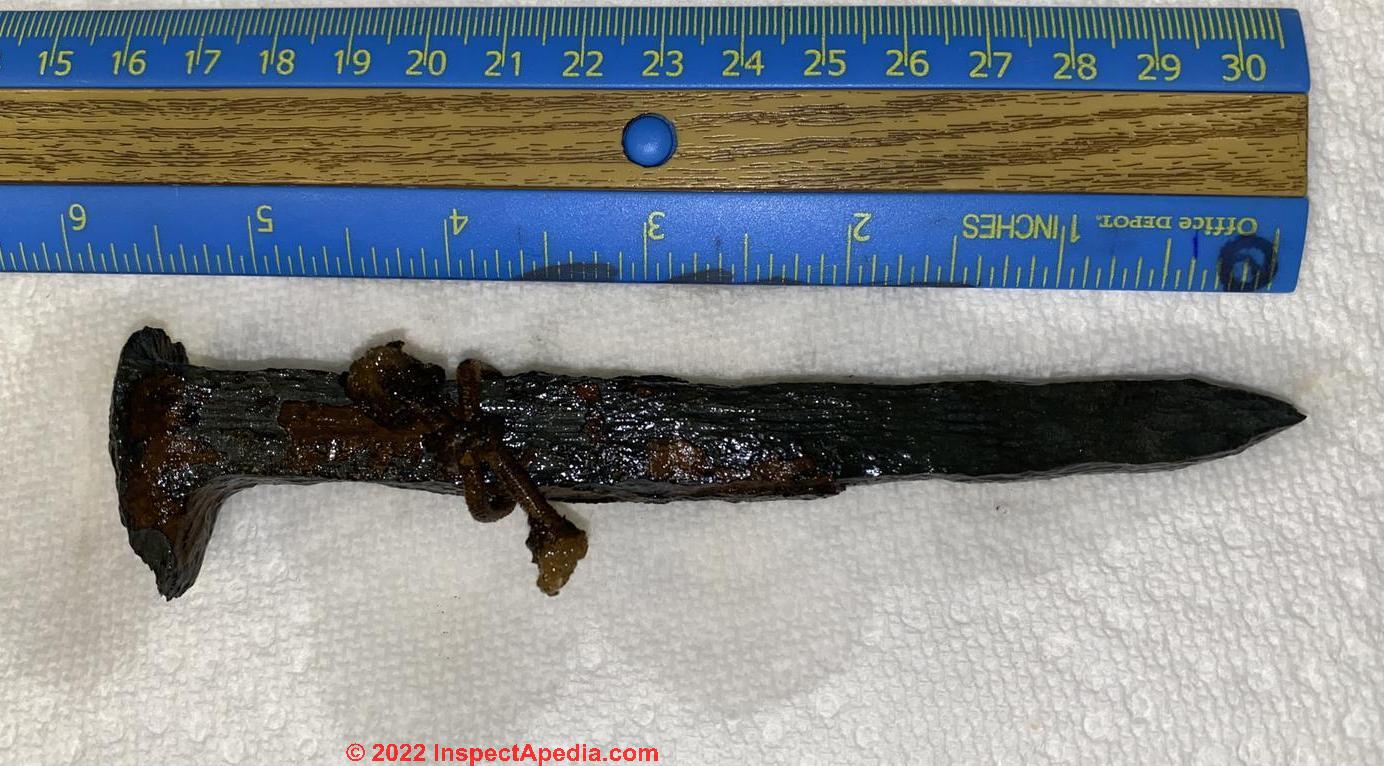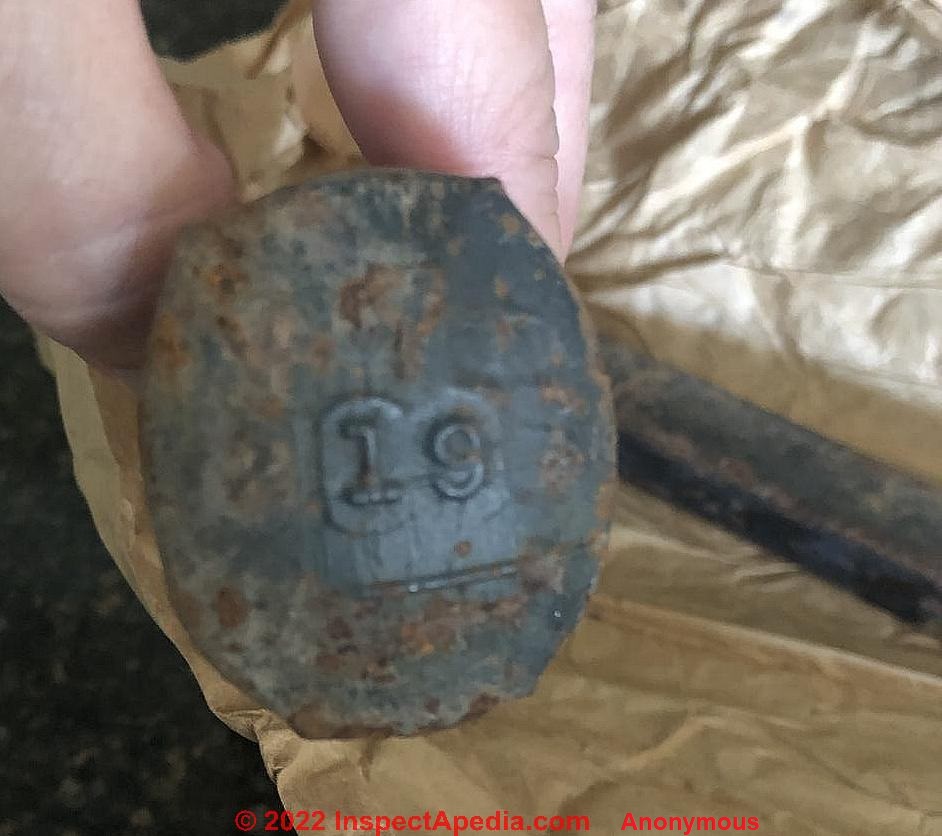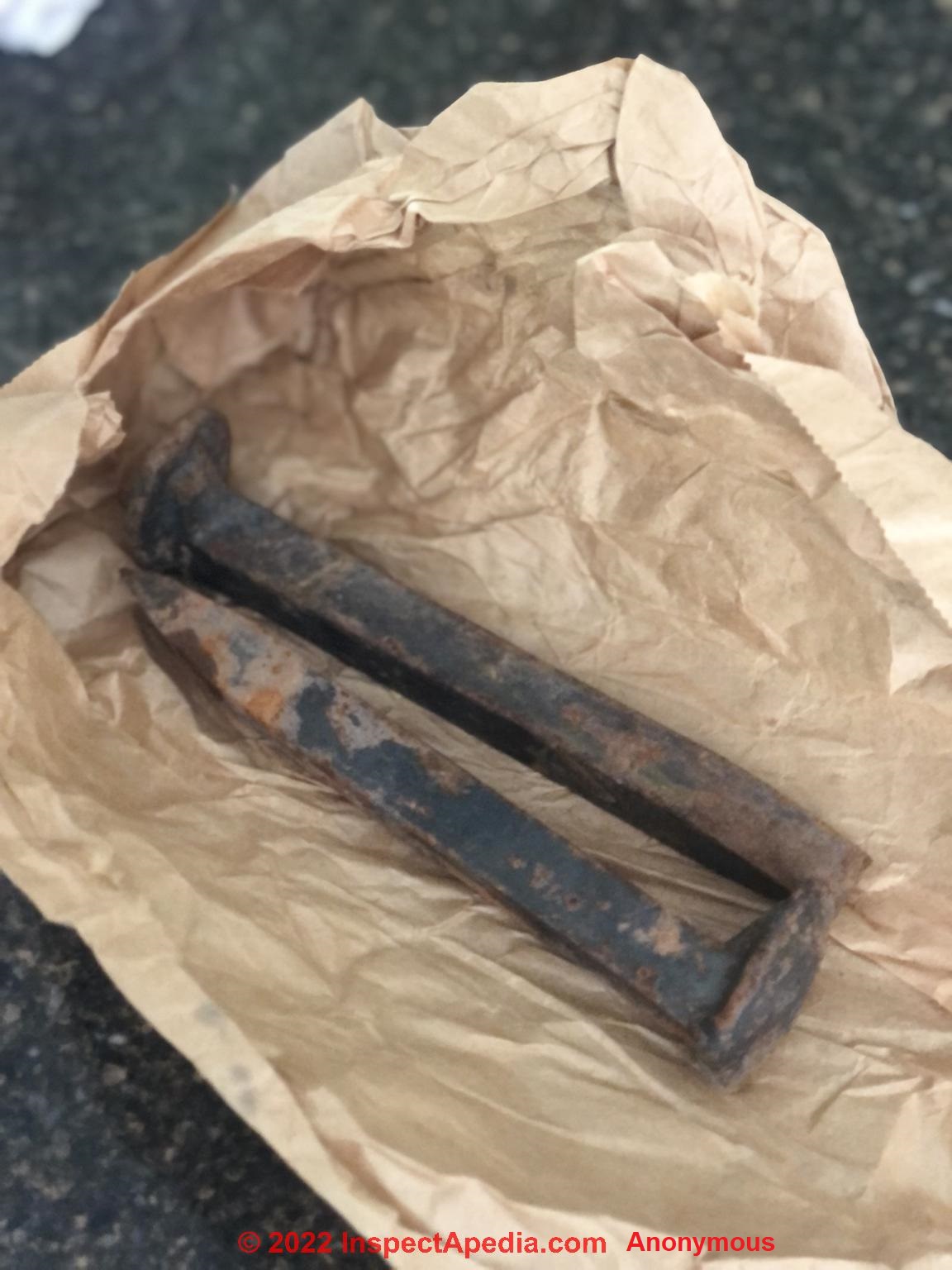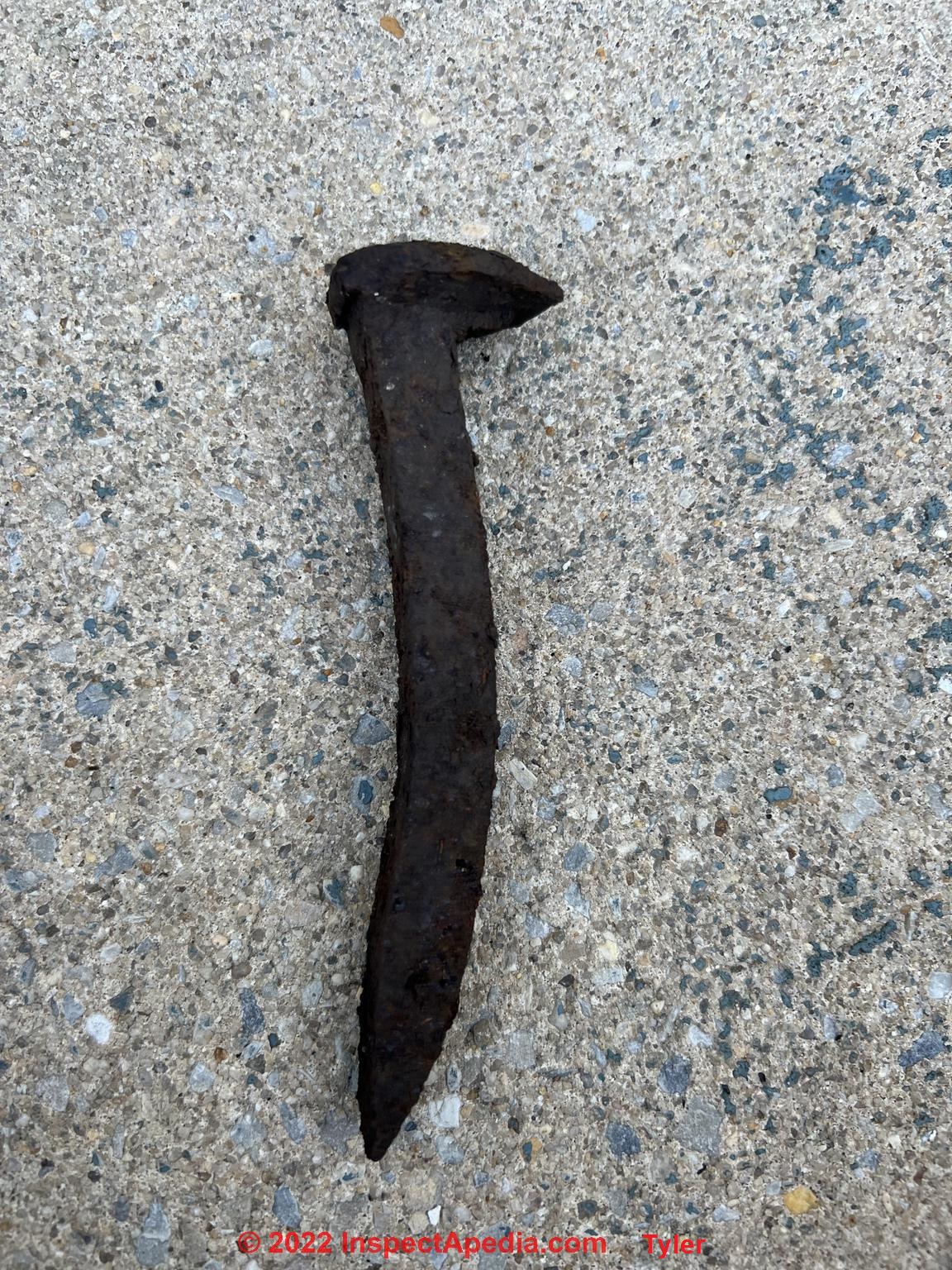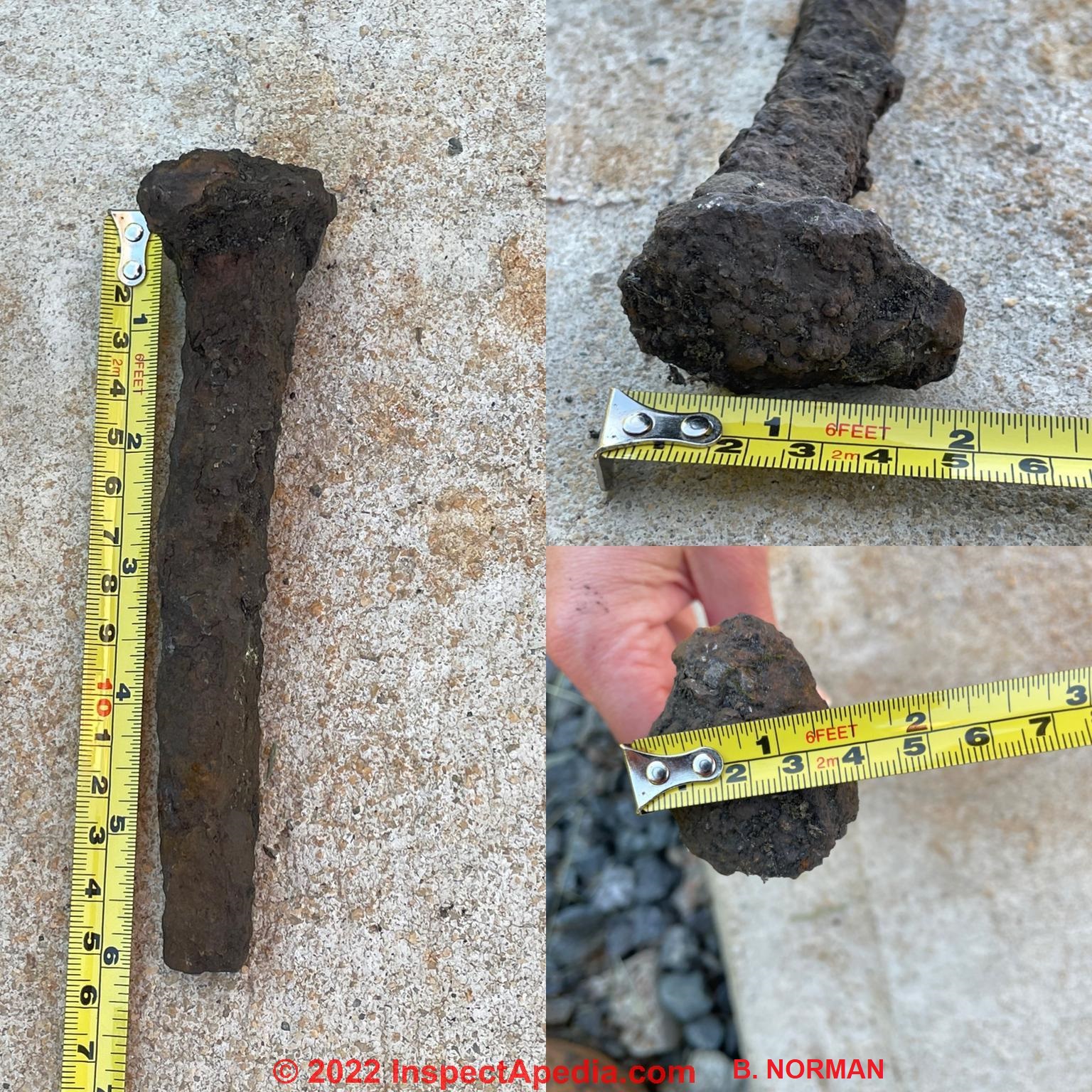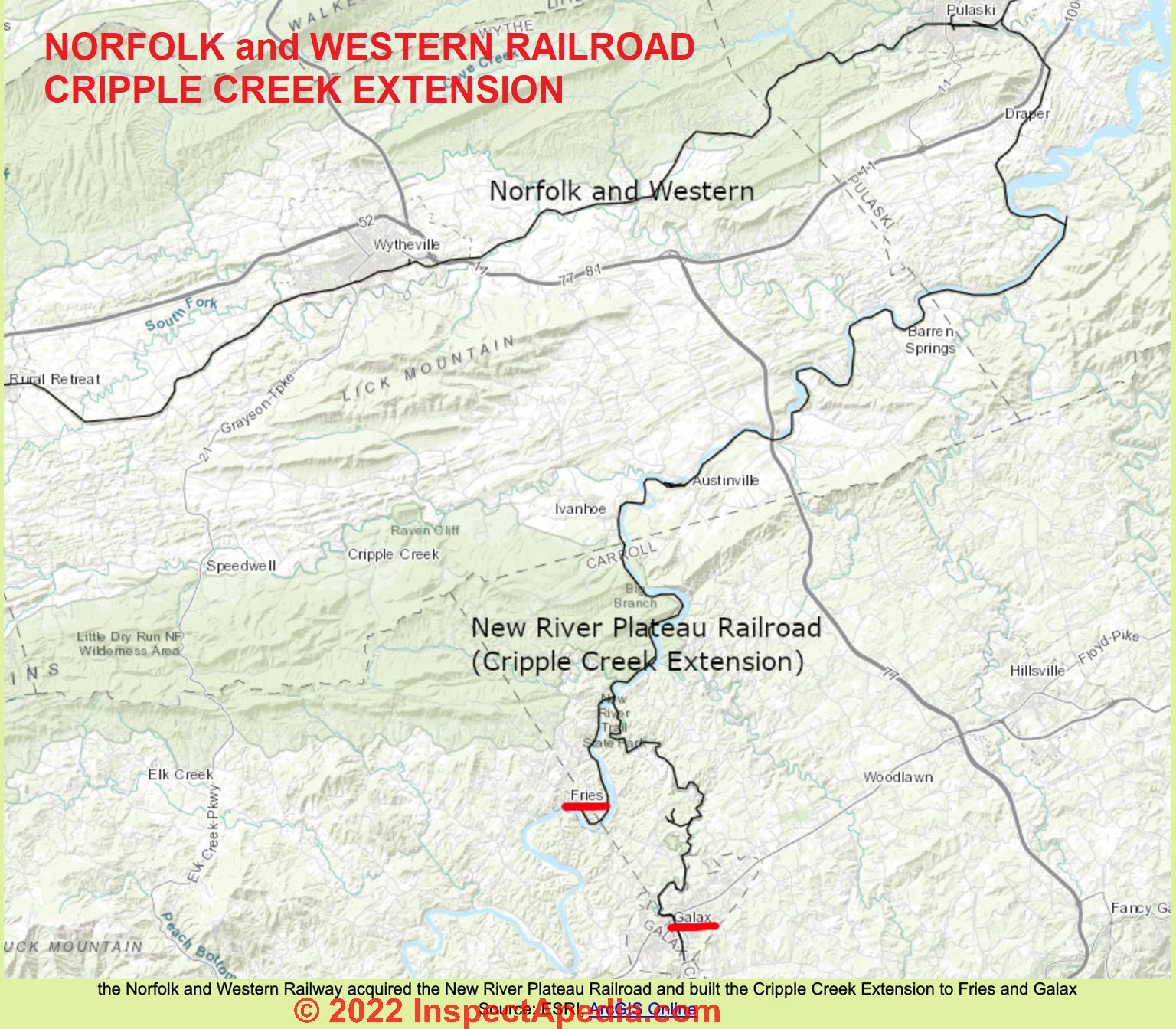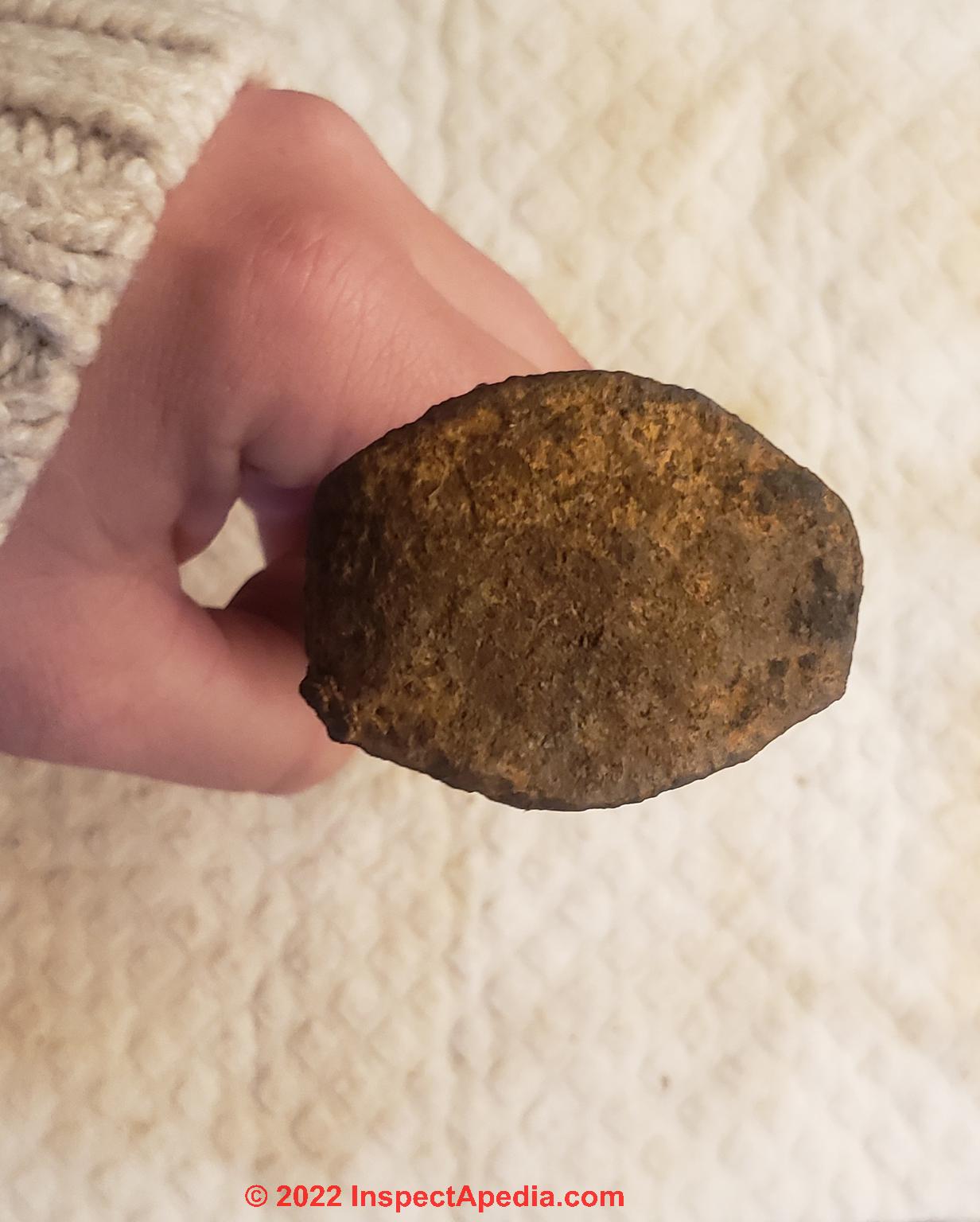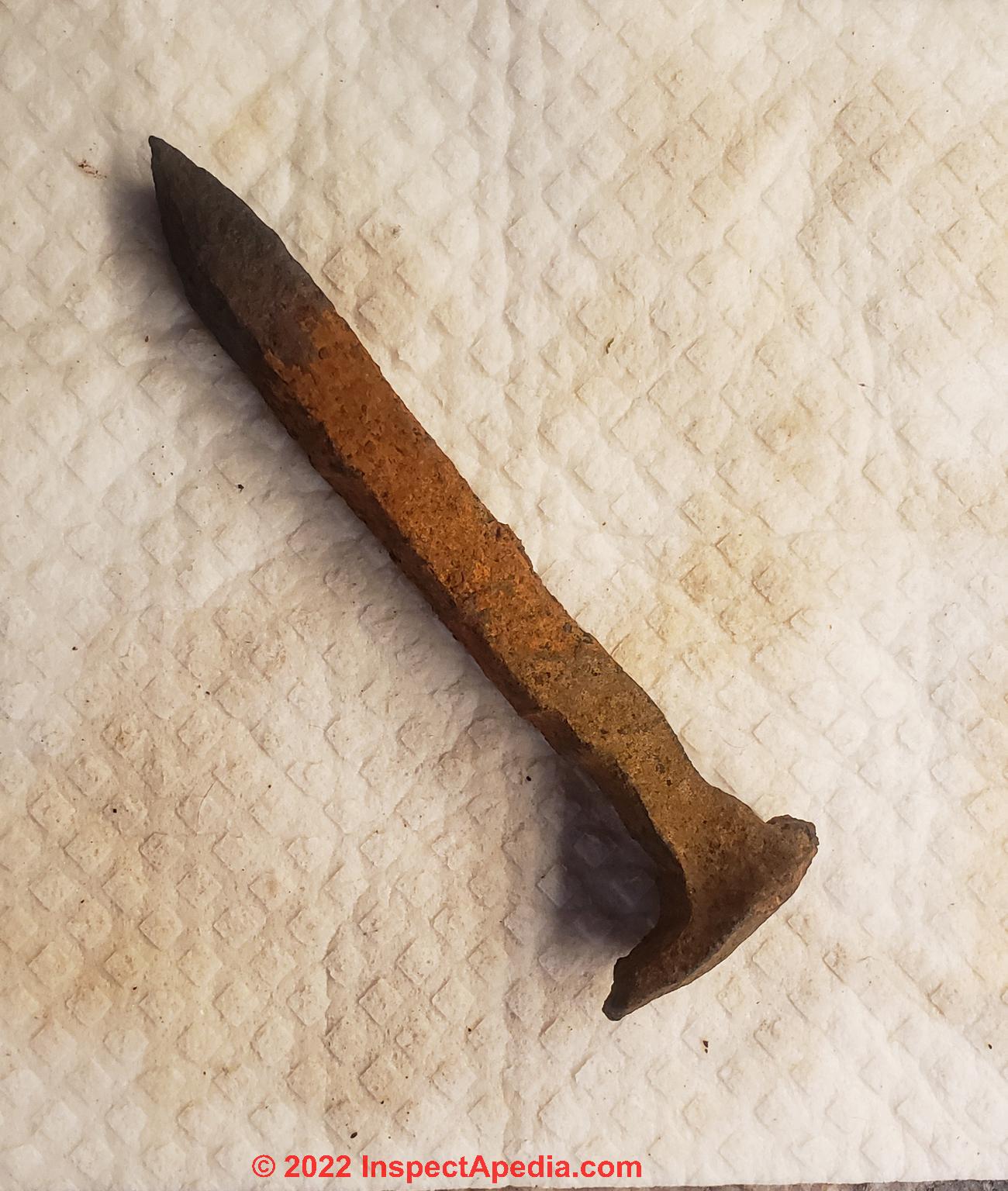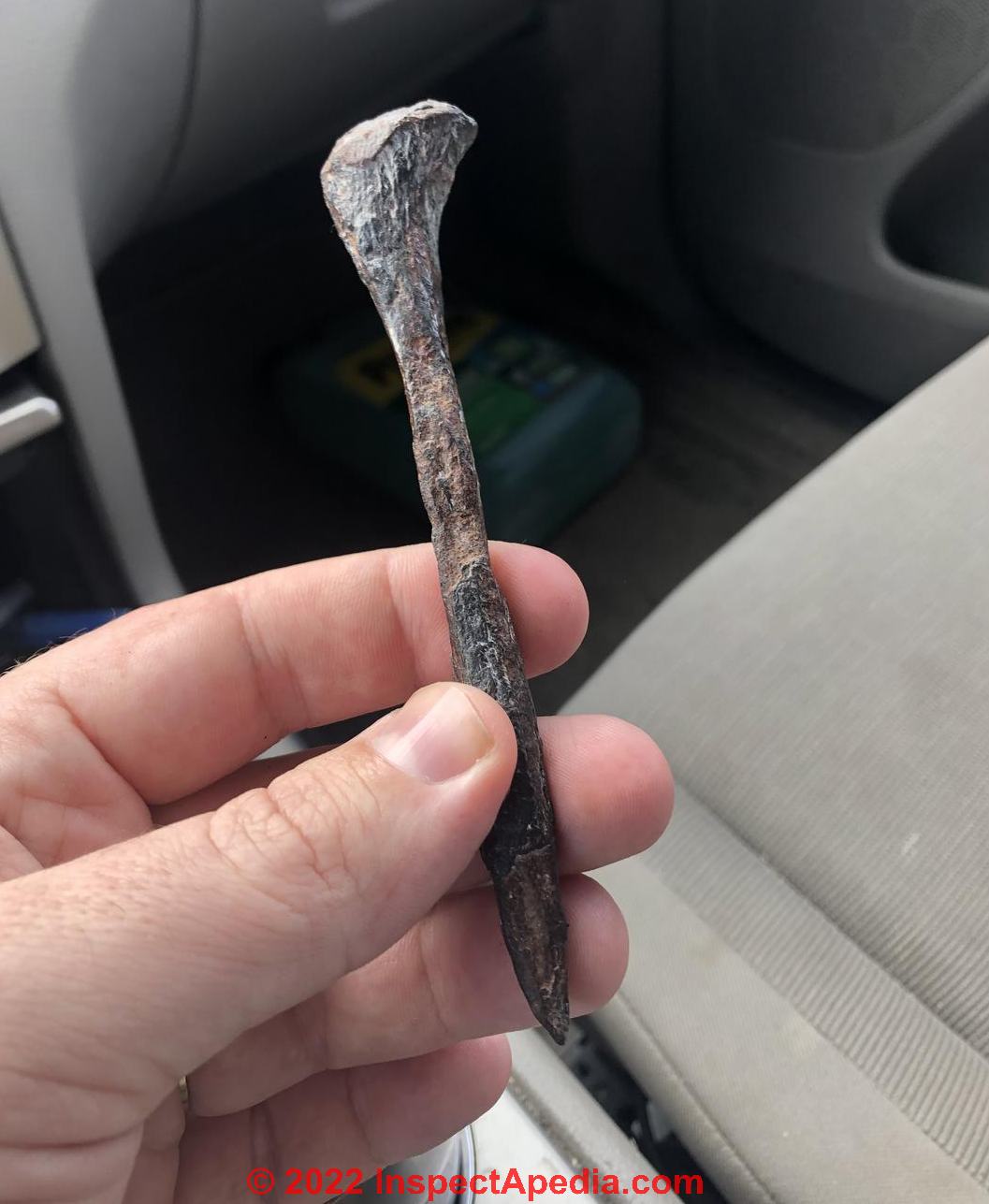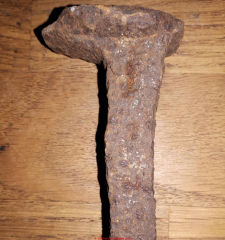 Railroad Spikes: History & Photos
Railroad Spikes: History & Photos
Age of old vs modern railway spikes
- POST a QUESTION or COMMENT about determining age of antique nails & spikes
History & identification of railroad spikes: types, patents, photos, uses.
This article series describes and illustrates antique & modern hardware: door knobs, latches, hinges, window latches, hardware, nails & screws can help determine a building's age by noting how those parts were fabricated: by hand, by machine, by later generations of machine.
InspectAPedia tolerates no conflicts of interest. We have no relationship with advertisers, products, or services discussed at this website.
- Daniel Friedman, Publisher/Editor/Author - See WHO ARE WE?
Railroad Spikes: history, identification, age, uses
1832 - Present: Cut Spikes, Railroad Spikes & Offset Head Nails
In our images above and also in Alyssa's railroad spike photos shown here you'll notice that the head of these large railroad spikes sport an offset head.
[Click to enlarge any image]
The larger lip of the offset head on these large spikes, also called crampons, was used to secure the bottom edge of the rail to the steel plate upon which the rail rests.
As the railroad spike is driven through the plate and onwards into the railroad tie or (sleeper), the combination of spike, tie-plate, and sleeper hold the rail in place in the stone-covered bed (ballast) of the railway.
Invention of the railroad spike is credited to Robert Livingston Stevens, president of the Camden & Amboy Railroad, and first used in the U.S. in 1832. (Wikipedia). Stevens is also credited with invention of the T-shaped rail on which rail cars run.
However a patent for railroad spikes search finds slightly-later dates and inventors for citation, as we illustrate below.
Photos above and below: traditional railroad spikes in-use - from http://www.rail-fastener.com/agico-railroad-spikes.html
In the U.S. the transcontinental railroad was completed on May 10, 1869 when the last spike, "the golden spike", was driven into a tie at Promtory Summit, Utah.
Early Railroad Spike Patent History: 1834 & Later
Our photo of this hand-wrought railroad spike is the oldest we've seen, possibly from the Civil War era. Thanks to reader John for this contribution. The very first hand wrought spikes may have lacked the protruding cam under the head - added to help hold the railroad tie in place, making this spike likely to date from 1850 or lager.
The earliest railroad of any form in the U.S. was constructed in 1764 for military purposes at the Niagara portage in Lewiston, New York. - (LOC)
The first actual charter for a railroad in the United States was granted to Stevens in 1815, but surveying and construction on the first U.S. railroad, the Baltimore and Ohio, chartered in 1827, didn't really begin operation until 1830 when the first fourteen miles of track were completed. (Library of Congress, cited below).
Railroad spikes may have been hand-forded in small quantity, but almost immediately the need for railway spike producing machines would have been evident from very early in the history of railroads.
[Click to enlarge any image]
So although you might expect to find a railroad spike that's hand forged but in our opinion that'd be uncommon.
Consider that by the time railroads were being built across the U.S. Continent the volume of spikes needed to secure rails to ties was so enormous that hand-forging these fasteners would not have been reasonable.
But those off-set or "hook-headed" spikes may date from about 1850.
And as we discuss here, the very first railroad spikes were made of wood - and were quickly found to be of short life.
Early Railroad History, Documents, Patents
Below are examples of very early railroad documents & patents in the U.S.
- Bloodgood, S. DeWitt. "ART. XVIII. SOME ACCOUNT OF THE HUDSON AND MOHAWK RAIL ROAD [PDF] American Journal of Science and Arts (1820-1879) 21, no. 1 (1832): 141.
Below we recount two of the earliest US patents of railroad spike or hook-headed spike machines.
- Harvey, T. W. (1834). Specification of a patent for an improvement in Nails and Spikes, denominated the Grooved and Flanched Spike. Granted to THOMAS W. HARVEY, Jamestown, Chataque county, New York, September 16, 1832.
A copy of this hand-written patent is on display at the Franklin Institute in whose Journal it appeared.
Journal of the Franklin Institute, of the State of Pennsylvania, for the Promotion of the Mechanic Arts; Devoted to Mechanical and Physical Science, Civil Engineering, the Arts and Manufactures, and the Recording of American and Other Patent Inventions (1828-1851), 13(3), 183.
Harvey, Thomas W. Journal of the Franklin Institute, of the State of Pennsylvania, for the Promotion of the Mechanic Arts; Devoted to Mechanical and Physical Science, Civil Engineering, the Arts and Manufactures, and the Recording of American and Other Patent Inventions (1828-1851); Philadelphia Vol. 13, Iss. 3, (Mar 1, 1834): 183. - Meyers, Rolland, Date Nails, retrieved 2022/06/07, original source: https://www.rta.org/assets/docs/Other/date nail history cohs.pdf Email: rolland@rollandmeyers.com
- White, Edwin B., ROTATING SPIKE MACHINE [PDF] US Patent No. 6,666 granted Aug. 28, 1849 device for making railroad spikes.
Below: White's 1849 rotating railroad spike machine patent image.
- Hardaway, Moore, MAKING SPIKES [PDF] US Patent No. 7,508 granted Jul. 16, 1850, machine for making hook-headed and other wrought-iron spikes.
Excerpt: The nature of 'my invention and improvement consists in a new and useful combination and arrangement of mechanical devices, and modes of operating the same, by which the spike is cut from the heated rod, gripped and held firmly between horizontal dies-bent down at one end and hook- headed and rolled out longitudinally at the other end, and pointed between an inclined stationary and a rolling die, the several operations being performed almost simultaneously and at every revolution of a cam shaft, operated by steam or other power, by which hook spikes of a superior character are produced. - Henwood, James. "Railroad Spikes, a Collector's Guide." (1985): 118-118. Available at the U.S. Library of Congress and perhaps elsewhere.
- Schuessler, Raymond. "Wood in railroad history." Forest Products Journal 48, no. 1 (1998): 5.
Excerpt:
In the early history of US railroads, wood was used for rails. - Swift, Horatio N., SPIKE MACHINE [PDF] US Patent No. 7,749 granted Oct. 29, 1850, machine for making Railroad or "hook-headed spike"
- Harrison, John. KEY for RAILROAD SPIKES [PDF] U.S. Patent 633,838, issued September 26, 1899.
- Hubbard, Joseph R. "Railway-rail joint." U.S. Patent 744,553, issued November 17, 1903.
- Webber, Roy Irvin. HOLDING POWER of RAILROAD SPIKES [PDF] (1906).
Excerpt:
The determination of a proper fastening between the rail and the tie has become a matter of considerable importance.
During the period when the supply of suitable hard wood timber was sufficient, the ordinary spike satisfactorily fulfilled the requirements of traffic; but with the increase in the amount of traffic handled, and the heavier weights of cars and locomotives, and also with the use of soft deciduous and coniferous woods for ties, the common spike has proved deficient.
- Butts, Carl K. RAILROAD SPIKE [PDF] U.S. Patent 933,743, issued September 14, 1909.
Excerpts:
This invention relates to railroads and more particularly to rail fastening means, and has for its object to provide a fastening means of this character including a spike having a main shank and a supplemental shank so arranged that the supplemental shank will be brought into engagement with a portion of the main shank when driven into material, thus anchoring the spike and preventing its disengagement.
...
When the spike is driven home, the engagement of the bevel face 9 with the material of the tie will cause the shank 6 to bend 50 laterally in the direction of the rail, and the face 11 of the supplemental shank 10, com ing into engagement with the material of the tie, will cause this shank 10 to bend in the same direction.
By reason of the fact that the shank 10 is thinner than the shank 6, as shown in the drawings, the bending of the shank 10 is more abrupt than that of the shank 6, and consequently the lower end of with the rearward face of the shank 6, the spike. being thus securely locked in the tie.
- Harrison, John, KEY for RAILROAD SPIKES [PDF] U.S. Patent No. 633,838, issued Sept. 26, 1899
Excerpt:
Be it known that I, John Harrison, a citizen of the United States, residing at Philadelphia, county of Philadelphia, and state of Pennsylvania, have invented a new and useful improvement in Keys for Railroad Spikes, of which the following is afull, clear, and exact description, reference being had to the accompanying drawings, which form apart of this specification.
My invention has for its object to produce a new and improved key for spikes,by means of which old spikes and old cross-ties whose efficiency have been impaired or destroyed by the spikes wearing or working loose may be again rendered available and efficient as a means for firmly fastening the rail or rail-chair upon the ties. - Thompson, Linda. Building the transcontinental railroad. Carson-Dellosa Publishing, 2013.
- H.M. Lines RAIL JOINT [PDF] U.S. Patent No. 1,001,966, granted Aug. 29. 1911
Excerpt:
This invention relates to improvements in rail joints to enable a pair of rails to be secured together, without the necessity of employing bolts or other like devices, the in vention consisting in the construction, com bination and arrangement of devices herein after described and claimed. - U.S. Library of Congress, THE BEGINNINGS of AMERICAN RAILROADS and MAPPING [PDF] U.S. Library of Congress, retrieved 2022/04/26, original source: https://www.loc.gov/
Excerpts:
Railways were introduced in England in the seventeenth century as a way to reduce friction in moving heavily loaded wheeled vehicles.
The first North American "gravity road," as it was called, was erected in 1764 for military purposes at the Niagara portage in Lewiston, New York. The builder was Capt. John Montressor, a British engineer known to students of historical cartography as a mapmaker.
...
The first railroad charter in North America was granted to Stevens in 1815. Grants to others followed, and work soon began on the first operational railroads. Surveying, mapping, and construction started on the Baltimore and Ohio in 1830, and fourteen miles of track were opened before the year ended.
Shown here: illustration of the effect of railroad spikes in displacing fibers in wood railroad ties, in Webber's Holding Power of Railroad Spikes, cited below. Note that all of the driven-type railroad spikes are of the offset head type.
- Webber, Roy Irvin. HOLDING POWER OF RAILROAD SPIKES [PDF] (1906) Thesis for degree of civil engineering, College of Engineering, University of Illinois (courtesy of the University of Illinois Library)
Excerpt:
The determination of a proper fastening between the rail and the tie has become a matter of considerable importance. Duringthe period when the supply of suitable hard wood timber was sufficient, the ordinary spike satisfactorily fulfilled the requirements of traffic; but with the increase in the amount of trafiic handled, and the heavier weights of cars and locomotives, and also with the use of soft deciduous and coniferous woods for ties, the common spike has proved deficient.
Variations in the formof the ordinary spike have been developed, and new forms of spikes have been devised in an attempt to overcome the loss of efficiency attendant upon the use of inferior timbers.
In view of these conditions, and the meager supply of published data on the holding power of spikes in ties, the writer has carried out a series of experiments to determine the resistance to withdrawal offered by the same type of spike in different timbers and by different forms of spikes in the same timber, and also to determine whether or not the preservative has any influence upon this resistance.
Photo below: "Babe White driving first spike in U.S. Railroad, driving the first spike in U.S.Road at Ship Creek, (Alaska) ca 1900. Part of: Frank and Frances Carpenter collection (Library of Congress). Ship Creek is an Alaskan river at whose mouth is found Anchorage. - Gift; Mrs. W. Chapin Huntington; 1951. The woman driving the spike is identified in other historic data as Martha White.
below, an enlarged excerpt showing the railroad spike in this photo.
Date Nails Used in Dating Railroad Ties Help Identify Railroad Spikes & Spike Age
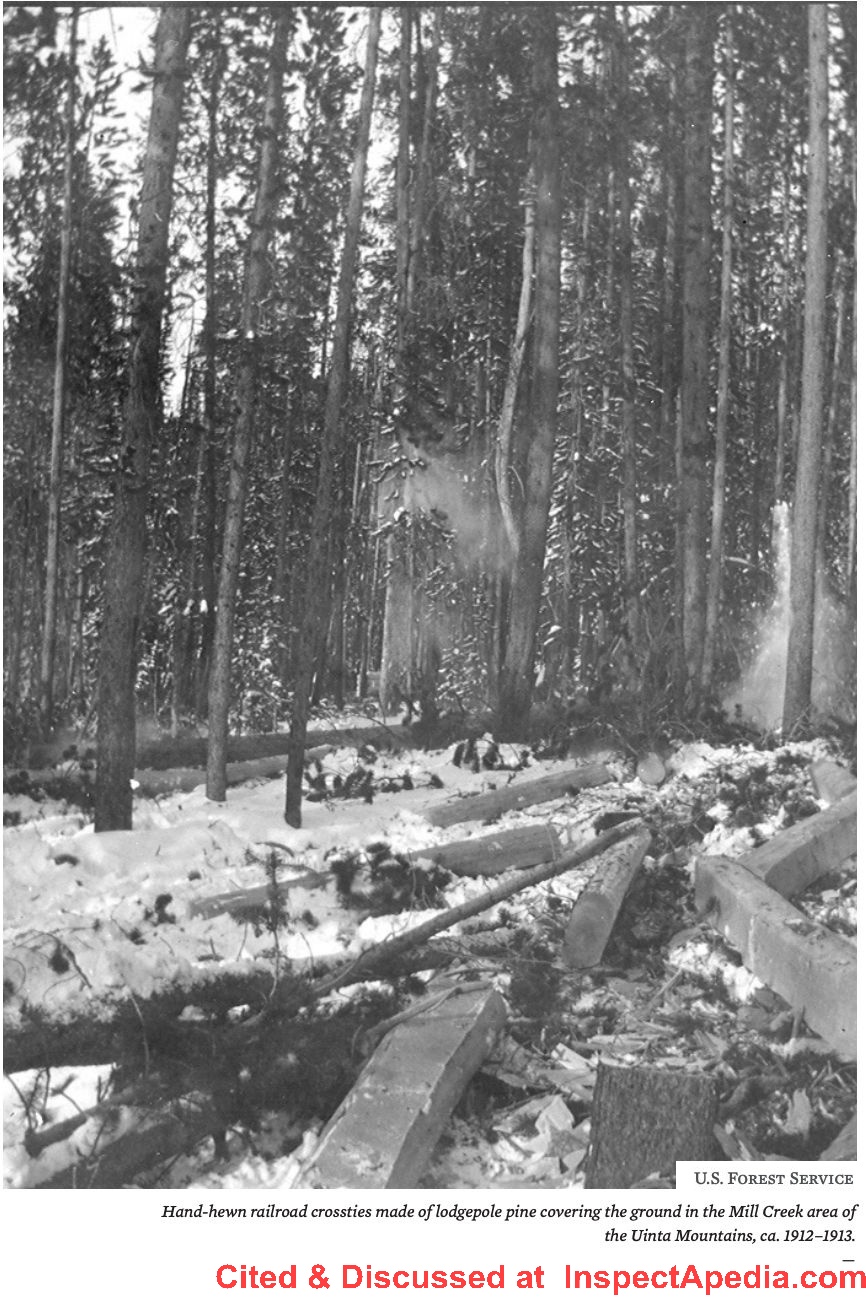
Illustration: hand-hewn railroad crossties cut from lodgepole pine, ca 1912 - 1913 - US Forest Service (Merritt 2016).
In the U.S. beginning in 1909 some railroads used date nails, a specially-manufactured nail that included a year encoded in the nail head, possibly also including a shape or image that identified the nail manufacturer.
So if you by slight chance and luck found an old railroad spike still in a railroad tie where such a nail is also found, that date nail will give a reasonable guess at the earliest possible age of the railroad spike itself.
We say possible date rather than definite date because you can't be certain that a given railroad spike is not a replacement.
Jeffrey A. Oaks "Date Nails" gives a nice history of the use of date nails and includes some examples of date codes for specific railroads. - retrieved 2022/12/31, original source: University of Indianapolis, 1400 East Hanna Avenue Indianapolis, Indiana 46227 Main: 317-788-3368 Web: https://uindy.edu/cas/mathematics/oaks/datenails/
Oaks also cites the use of date nails on poles that have been documented by Scott Weed at his page "Collecting Date Nails with the Nailhunter - a pictorial guide to date nails" - Web: http://nailhunter.com/ - retrieved 2022/12/31
General date nail age & use guidelines for railroad ties in the U.S.
- 1897 Earliest date nail use known: Mississippi River & Bonne Terre
- 1899 Most railroads began using date nails, beginning with the Chicago & Eastern IL and several others
- 1920s Most railroads were using date nails to track railroad tie condition and life
- 1930-1939 peak of date nail use in railroad ties
- 1950 - 1970 use of date nails declined
- 1971 - 2000 little or no use of date nails
- 2001 - aluminum date nail traced by George Oliva per Jeffrey Oaks
- From the 1970s to present railroads relied increasingly on stamps impressed into the ends of railroad ties to track tie life.
Other methods were also used to keep track of the age and thus monitor the condition of railroad ties such as tacking on a brass number-tag or making identifying notches or cuts into the tie itself - later leading to end-stamps or brands in railroad tie ends.
General date nail age & use in Europe
Oaks points out that lumber shortages in europe led railroads in England, France and Germany to begin treating railroad ties with chemical preservatives earlier than was done in the U.S. Date nails were in use in France possibly as early as 1859 and certainly by 1870.
Railroad Tie & Date Nail Use & History, Resources
Above: a modern machine-made railroad tie spike.
- Aldrich, Mark. "From forest conservation to market preservation: Invention and diffusion of wood-preserving technology, 1880-1939." Technology and culture 47, no. 2 (2006): 311-340.
- DeLeuw, TECHNIQUES for IMPROVING the RAILROAD MAINTENANCE-OF-WAY EQUIPMENT EVALUATION PROCESS [PDF] De Leuw, Cather & Company, 1201 Connecticut Avenue N.W., Washington D.C. 20036 (April 1979) Final Report - retrieved 2022/12/31 original source: railroads.dot.gov/sites/fra.dot.gov/files/fra_net/14655/Techniques for Improving the Railroad Maintenance of Way Equipment Evaluation Process Apr 1979.pdf
Abstract:
This report presents the results of a study of techniques for improving the railroad maintenance-of-way equip~ent evaluation process.
The approach involved a review of existing methods, interviews with equipment manufacturers and railroads, discussions with industry representatives, and an equipment reliability study.
Conclusions include the standardization of published data, indexes for the determination of the effects of man-machine interface, the applipation of procedures for quality testing, and functional characteristics analysis methods. - Merritt, Christopher W. “WOODEN BEDS for WOODEN HEADS”: Railroad Tie Cutting in the Uinta Mountains, 1867-1938 [PDF] Utah Historical Quarterly 84, no. 2 (2016): 102-117.
Excerpt:
Between 1867 and 1938, loggers cut a low estimate of ten million railroad crossties from the densely forested slopes and terraces of the Uinta Mountains’ North Slope (fig.1 - shown above on this page - Ed.).
In nearly 500,000 acres stretching from the Bear River on the west to Henry’s Fork on the east, professional (full time) and subsistence or seasonal loggers harvested millions of lodgepole pines to feed the growth of the United States’ railroad infrastructure.
Although the Weber and Provo headwaters and several other smaller drainages in Utah also provided ties, the North Slope of the Uintas was uniquely situated to yield a more than adequate supply.
From the 1860s to the 1930s, tie cutting was completed by hand with a broad axe during the winter; the ties were floated to market using major rivers and creeks during the spring thaw, and delivered to the railroads in summer. - Mishkar, Larry. "Date Nails and Railroad Tie Preservation. 3 vols." (2002): 40-42.
- North American Railroad Maintenance of Way Association, PO Box 420159, Kanarraville, UT 84742 USA. Douglas W. Groff (Ed.) Email: doug@whitmoreprinting.com
- Oaks, Jeff. Date nails and railroad tie preservation. University of Indianapolis, 1999.
- Oaks, J. A. "History of Railroad Tie Preservation." Date Nails Railrroad Tie Preservation (1999): 19-75.
- Von Schrenk, Hermann. The Decay of Timber and Methods of Preventing It. No. 14. US Government Printing Office, 1902.
Contextual Clues in Dating Railroad Spikes
Our discussion on this topic can now be found
at RAILROAD SPIKE AGE - CONTEXTUAL CLUES
including information on wooden pegs for use in railroad construction
Modern Railroad Dog Spikes
With special thanks to railroad spike manufacturer Agico Group, cited below, we show a snapshot of modern railroad dog spikes and their specifications.
- Source: Dog Spike, Agico Group,5-9F, Building 2, Huaqiang New Times, Xian'ge Avenue, Hi-Tech Industry Development Zone, Anyang, Henan, China, Email:
info@rail-fastener.com Tel: +86 372 5081 703 - retrieved 2022/06/07, original source: http://www.rail-fastener.com/Dog-Spike.html
Excerpt:
A rail spike, also known as a cut spike or crampon, is a large nail which is used to fix rails fastening system to railroad in the track. The main function is to keep the rail in gauge.
A dog spike, also called cut track spike, is often used to fasten T-shaped railway track to wooden sleepers, to secure a rail and tie plate to the ties in track, which has a pointed penetrating head with square shank, and the underside of the spike head is sloped to compromise the top of the rail base.
At our Rail Spike Workshop Dog spikes of various sizes are available to meet the customized requirements of penetrating length of the spikes. The most popular track spikes are the 5/8” ×6” and 9/16” ×5-1/2” for smaller rail sections, especially in North America, especially US market
Special Markings, Stamps, Logos on Railroad Spikes
Information aboutr railroad spikes marked "Gib.co" ?
I have an old spike with ‘Gib.co.’ inscribed. .
I cannot locate info re Gib.co online.
Any info you may have
Moderator reply: GIB forces on railroad spikes & railroad tie plates
@Sharon S,
It would be most helpful if you could post a photo of your railroad spike and its marking.
Illustration above, related to railroad spikes and their history and age, is a railroad tie plate. Often the tie plates include manufacturer identification and on occasion clues to the hardware age such as a US Patent number - none of which are likely to be found on the spikes themselves.
Railroad Tie Plate, BRS Co. Pat. 1-27-2 as for sale on e-Bay in November 2022, described by the vendor as Railroad Tie Plate Vintage Blacksmith Steel Forge Anvil 9" x 8" - 7 lbs. 10 oz. possibly one of several railroad rail related patents by J.A. Byers.
We researched your question and found that the word "gib" appears (among in many other places) in railroad literature where it's used to refer in general to
A bolt or wedge made from metal [or another material] used for holding a machine [or other] part in place.
or a gib may have been used to refer also to a track plate, gib plate (railroad tie plate), or on the rail line, a railroad spike.
I've looked for a railroad spike manufacturer whose name began with "Gib" without success but that's probably what you've found.
For an interesting discussion of forces on railroad rail, spike, plate and ties that talks about gibs and gib-forces and in fact interesting 1970s railroad research sponsored by the U.S. Office of Freight Systems, see
- OVERVIEW of FREIGHT SYSTEMS R&D [PDF] (1997) Office of Freight Systems, Office of Research and Development Federal Railroad Administration, Washington D.C. 20590 - retrieved 2022/11/20, original source: https://railroads.dot.gov/sites/fra.dot.gov/files/fra_net/15917/1977_OVERVIEW OF FREIGHT SYSTEMS RAND D.PDF
and included in the original of this document were the following - Blanchfield, J.R., M.A. Kenworthy, INTERMODAL CARS, NEW DEVELOPMENTS [PDF] NTIS
Abstract Excerpt: Intermodal railcars used for "piggyback" trailer and container transportation are becoming the subject of increasing design interest. - Wiseman, R.L., H.C. Ingrao, W.F. Cracker, OPTICAL ACI - A NEW LOOK [PDF] Optical Automatic Railroad Car Identification (OACI) systems improvements.
- Cappel, K.L. & G.R. Fay, TRUCK PERFORANCE - FRICTION SNUBBER FORCE MEASUREMENT SYSTEM [PDF] NTIS
- Jacobs, M.E., ENERGY CONSERVTION - MULTIPLE UNIT LOCOMOTIVE THROTTLE CONTROL [PDF] NTIS
- Gray, D.E., FAST MECHANICAL EQUIPMENT - Test Results to Date, Future Plans [PDF] NTIS
Abstract:
This paper summarily describes the results to date, after approximately 60,000 miles of train operation, on the mechanical equipments being conducted at the Facility for Accelerated Service Testing (FAST). Specific results are presented on wheel flange wear, wheel failure modes and premium truck performance. Future plans for FAST mechanical testing are also described. - FREIGHT CAR TRUCK DESIGN OPTIMIZATION PROJECT - Phase I - Magnetic Data Tapes [PDF] NTIS,
- Gross, A.G., RAIL DYNAMICS LABORATORY PERFORMANCE REQUIREMENTS & HARDWARE CONFIGURATIONS, Office of Freight Systems,
Federal Railroad Administration,
Washington, D.C - un-dated, probably also ca 1977 Rail-Dynamics-Lab-Performance-Requirements-Hardware-Configurations-Gross.pdf
Abstract: This paper describes the Rail Dynamics Laboratory (RDL) facility at the Transportation Test Center (TTC), Pueblo, Colorado. Two unique test machines, the Vibration Test Unit (VTU) and the Roll
Dynamics Unit (RDU) are to be housed in this facility to perform dynamic tests of full-scale railroad and transit industry vehicles. Both the VTU and RDU performance requirements and hardware configurations are described.
Gib plates are also discussed in
- Special Specification 4076 Ballasted Track Construction and Rehabilitation - Texas DOT, https://ftp.dot.state.tx.us/pub/txdot-info/cmd/cserve/specs/2014/spec/ss4076.pdf
- What Every Railroad Worker Should Know About The Federal Railroad Safety Laws and Regulations
gib is cited as
§229.67 Trucks A visual inspection of each truck frame shall be performed to determine that it is not broken or have a crack in a stress area that may affect it’s structural integrity. The securing arrangement to prevent the truck and locomotive body from separating in case of a derailment must be in place and securely fastened.
The truck may not have a loose tie bar or a cracked or broken center casting, motor suspension lug, equalizer, hanger, gib or pin. - https://static.smart-union.org/worksite/PDFs/Booklets/What+Every+Railroader+Should+Know+(Larry+Mann+2014).pdf
S-marking on Railroad spikes intended for Switches
The most common marking that might be found on some railroad spikes that refers to a special railroad spike application is an “S” railroad spike.
The S was stamped into these special railroad spikes to indicate that this was an extra-strength r spike intended for use at switches where stronger lateral and dislocating forces occurred as the switch operated and then the engine and railroad cars passed over the switch.
Railroad switch illustration above excerpted from The Frisco Man March 1913 cited below.
- The FRISCO MAN March 1913 [PDF] Vol. VII, No. 3. - collection from December 1902 - September 1935, available through the Springfield Missouri Library The Library Center
4653 S. Campbell Ave.
Springfield, MO
65810-1723
Phone: (417) 616-0534 https://thelibrary.org/lochist/frisco/magazines/magazines.cfm
Frisco employee magazines were published to serve the interests of active and retired Frisco employees. This collection consists of 185 complete magazines dating from 1902-1935. The magazines are in PDF format.
...
Reader Comments, Questions & Answers About The Article Above
Below you will find questions and answers previously posted on this page at its page bottom reader comment box.
Reader Q&A - also see RECOMMENDED ARTICLES & FAQs
Trouble Finding information on self-tightening RR spike
A Fella in Minnesota, long dead, is said to have created a RXR Spike that tightened with age to the track plate. I’ve tried to look up information and have been told there’s no such animal.
Even the question was answered with unbelievable vileness.
Is it true?
At are all you guys permanently p****d off , or what? On 2023-01-24 by Nick Osborne -
Reply by InspectApedia Publisher
@Nick Osborne,
I'm sure sorry you've had a problem with your RR spike question but I am dead certain that you did not receive an impolite answer here at InspectApedia.com.
And honestly I don't recall seeing any version of your self-tightening railroad spike question here at this website.
We value our readers most highly: you are the reason the website exists at all.
So perhaps you were posting somewhere else.
We welcome comments, questions, content suggestions, and we are absolutely polite to every reader. The ONLY material we might edit or delete is that containing foul language, racism or similar biases, disrespectful or crude language.
InspectAPedia.com® is an independent publisher of building, environmental, and forensic inspection, diagnosis, and repair information provided to the public at no cost.
In order to absolutely assure our readers that we write and report without bias, we do not sell any products or services, nor do we have any business or financial relationships with any manufacturer or service provider discussed at our website.
We very much welcome critique, questions, or content suggestions for our web articles. Website content contributors, even if it's just a small correction, are cited, quoted, and linked-to from the appropriate additional web pages and articles - which benefits us both.
Working together and exchanging information makes us better informed than any individual can be working alone.
More about us is at ABOUT InspectApedia.com@Nick Osborne,
Continuing now with what we could find about your "self-tightening" railroad spike:Our research did not find a RxR spike with that exact property in its description, but you're dead right that the problem of loosening railroad spikes has been a concern in the railroad and track-laying industry from the outset of railroads.
A number of rail fastening system components: the rail profile, tie plate, spike, and tie, have tried to address this problem.
We found this interesting patent - a more modern one:
Stafford III, Richard J. "ACTIVE RAILROAD SPIKE AND TIE PLATE INTERCONNECTION THEREFOR." [PDF] U.S. Patent 5,024,381, issued June 18, 1991.
Abstract
A rail spike for holding a tie plate on a tie, embodied in accordance with the invention so that tie cutting is prevented, spike removal for track maintenance is facilitated, and a free rail load wave is allowed.This preferably is attained by providing the spike with left and right side tapered shoulders and a tapered rear surface, such that a unique wedging and swaging action occurs in the tie plate hole during a final driving of the spike, limiting the depth of penetration of the spike into the tie and securely maintaining the gauge of the tie plate on the tie.
And here's an interesting image from the Cheney RR spike patent:
by InspectApedia Publisher - Cheney, Tilly, Snyder RR spike patents
@Nick Osborne,
Continuing:
Also read these relevant patents that address the problem of loosening railroad spikes or tie plates, starting with a more famous one:
Cheney, Byron M. "METHOD OF APPLYING RAILS AND TRACK SPIKE THEREFOR." [PDF] U.S. Patent 1,604,806, issued October 26, 1926.
Excerpt:
In spikes as heretofore used, when driven into the tie the head comes in contact with the top of the rail base. When the spike is driven into the tie the wood fibre on all sides of the spike shank is bent down at an angle acting as a brace to retain or hold the spike down.As traffic moves over the track there is an upward and downward movement and to a greater or less extent a for ward movement of the rails. This movement is commonly known as wave motion.
The upward movement of the rail either re sults in the spike being pulled up or if the holding power of the tie is sufficient, in the tie moving up with the rail. When the spike is pulled it is common practice for the men to redrive them so that the head again has contact with the rail.
Due to the wave motion of the rail they are again pulled and again redriven, the result being that this alternate pulling and redriving of the spikes breaks, bends or wears off the points of the wood fibre surrounding the shank of the spike to such an extent that finally little.If any holding power is left and many spikes may be pulled with the fingers.
In time the spike hole is enlarged to such an extent that moisture readily into the heart of the tie and decay quickly follows, thus necessitating the replacement of the decayed tie.
Also the enlarging of the spike holes by the constant pulling and re-driving of the spikes permits a spread ing of the rails. Also due to the filing action of the rail as it moves up, and down throat cut spikes are quite common, that is the wearing away of the spike at the throat or just beneath the head, thus weakening the spike.Also by driving the head down so that it comes in contact with the top of the rail base as heretofore done, the spike heads are frequently broken.
This also occurs sometimes by the pulling action of the rail. Also when the spikes are pulled as stated by the waye motion of the rail, the tie plate is not held against the tie when the rail moves upwardly so there is an objec tionable rattle of the tie plates under traffic.
Tilly, Henry L. "RAILROAD PLATE WITH SPIKES." [PDF] U.S. Patent 2,417,385, issued March 11, 1947.Excerpt:
This invention relates to improvements in a railway tie plate and spike and has for its primary object firmly to anchor a railroad rail to a cross tie and hold it against accidental displacement.
Rush, Snyder Jacob. "Fastening for rails." U.S. Patent 2,690,876, issued October 5, 1954. - this is mis-cited by Google, the proper citation would be
Snyder Jacob Rush. "FASTENING FOR RAILS." [PDF] U.S. Patent 2,690,876, issued October 5, 1954.
Excerpt:
This invention relates to rail fastenings of the kind in which a railway rail is yieldingly held against a tie plate supported on a wood tie and, as one of its objects, aims to provide an improved fastening of this kind requiring only a relatively few parts which are adapted to be economically manufactured and installed.Another object of the present invention is to provide an improved rail fastening which, al though of a simple and inexpensive construction,
Will safely hold a rail in its proper position for a prolonged period of service and in a manner which will reduce to a minimum the longitudinal creepage of the rail and the cutting or crushing of the tie by the tie plate.
A further object is to provide an improved rail fastening of this character embodying a rail holding clamp which is connected with the tie by the use of a spike driven into a preformed bore thereof and in which the spike has increased holding power in the tie by reason of the fact that the portion of the tie surrounding the bore has been chemically treated and hardened and such tie portion thereby rendered resistant to shearing, crushing, fraying or rotting, and also by reason of the fact that the chemical estab lishes an adhesive bond between the Spike and the tie.
What was this spike used for?
This doesn't look like a railroad spike. Does anyone know what this type of spike was used for? Square tapering to triangular with a point? Square head but not offset to catch a rail? Any help would be appreciated. On 2022-10-27 by Jim Powell
email is: Macbeth55@gmail.com
On 2022-10-29 by InspectApedia-911 (mod) - square tapering to triangular with a point spike
@Jim Powell,
That looks like a machine made cut nail, or properly, when it's so large, a "spike" - but not a railroad spike.Take a look at the nail identification articles given in the recommended articles list on this page.
Typically large spikes were used for post and beam construction or similar applications where large timbers needed to be fastened.
Tomorrow and tomorrow and tomorrow...by Jim
@InspectApedia-911, This is not a nail. It is larger than a typical railroad spike.
It's large.
However, it doesn't have the usual lip to clamp down on the rail.
Creeps in its petty pace, from day to day...by InspectApedia (Editor)
@Jim,
Right, large spikes were used for a variety of purposes including Timber framing, dock construction.
Example of an early in RR spike
I found the attached spike while metal detecting last week. It was between the old Santa Fe railroad and the A.V.I. Line.
I assume it's an older railroad spike but, I'm not sure. Can you confirm whether it is and, what time period it would have been from? Thank you. On 2022-10-19 by Mike
by InspectApedia (Editor) -
@Mike,
OPINION (not researched fact) That's a very interesting RR spike - as it looks more hand-made than later rounded-headed versions that were mass-produced. Probably very early in RR history. 1860s perhaps.
Old railroad tie spikes with wire spring retainer
Removing old retaining wall, creosoted ties, some hand hewn, one had tie plate still attached with two intact spikes. Odd, spikes are joined with a wire spring type retainer that I have never seen before.
Searching references I have not found any info about these wires- springs- clips- retainers- what are they called, who made/patented them/ dates- possible value? still in the tie today. DD
saved the spikes and plate today before sending the load of ties to the dump. I will fwd a photo.
It is a straight wire that passes directly through holes drilled beneth the head of the spikes. The wire is straight. The plate has two holes on the side with the ridge and three holes on the inside, each off set. Will photo all.
Davis On 2022-10-11
by davis davis -
by InspectApedia-911 (mod)
@davis,
Quite often holes drilled through fasteners are there to permit installing a wire to prevent the fastener from rotating and thus coming unscrewed. As we said about try the add image button. You can post one photo per comment and as many photos with comments as you like.
Do try to post a photo using the Add Image button so we can take a look at what you've described.
Slotted hook on Florida coast - RR Spike?
Found these in Inverness Florida magnet fishing at and old bridge that used to be a train track but is now a bike trail. Any idea what this is? Found it magnet fishing along with a spike.
2022-09-14 by Ryan
by InspectApedia (Editor) (mod) -
@Ryan,
I can't say what that larger iron item is, but you might try an image search online, as well as a second image search using an edited copy of the image that makes it symmetrical.
It looks as if it was either a slotted device that was symmetrical or a type of hook intended to hook on the side of a steel vessel, such as might have held cables or ropes used to clean the sides of a ship or an iron tank.
Antonito rail road in colorado carriage bolt
Wondering what these might be. Found at and around antonito rail road colorado can you possibly make a educated guess as to age ?
On 2022-09-12 by Jason Connell
by InspectApedia-911 (mod) -
@Jason Connell,
Top to bottom:
a rusted carriage bolt with head at right end and nut at left end
A railroad spike
A modern machine made nailLet's get the surrounding context to put bounds on the age of railroad spike question - that's necessary because spikes were made in huge volume looking almost identical over more than 100 years now.
A quick search for "history of antonito rail road colorado" finds several websites giving history of that rail line, portions dating from 1880.
How are Double-Headed Dog Spikes Manufactured? Double-Headed RR Spikes
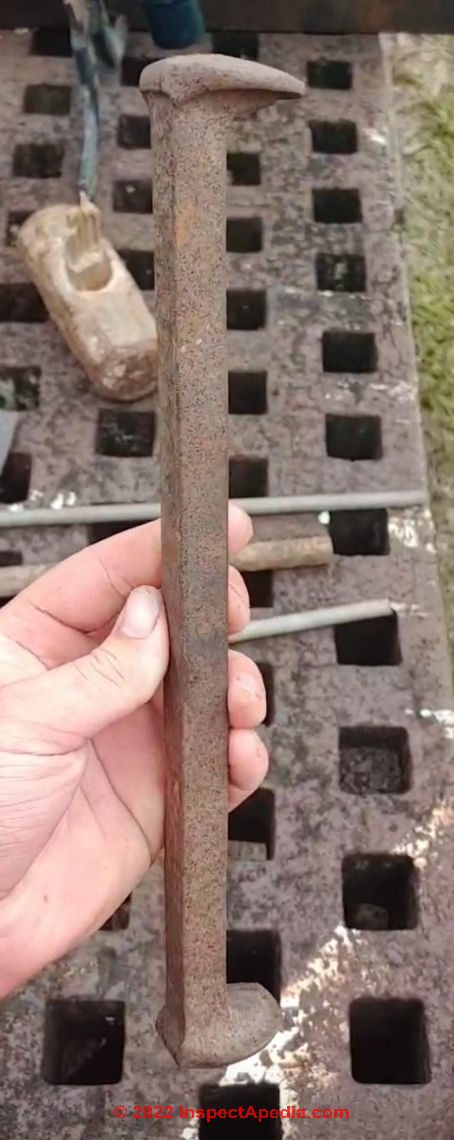 Do you know how the average dog spikes are manufactured?
Do you know how the average dog spikes are manufactured?
I recently saw this "double spike" at a blacksmithing event, really interested to know how it was made.
Was it a defect?
On 2022-09-04 by Matt
On 2022-09-04 by InspectApedia (mod) - double headed spike
@Matt,
I certainly don't think that spike is a mistake but more likely it was made for some special purpose and certainly not intended to be used to hold Railroad rails to the ties.
More likely someone made that as an effort to demonstrate blacksmithing skills such as joining two pieces of material together.
Look very closely to see if you can see a seam or joint.
Sometimes we see articles like that that are made by workers in the actual Factory where the normal product is produced.
For example someone may have used a long bar of stock and simply had fun fabricating a head on both ends.
In this article series you'll see details on the history of how these railroad spikes have been made and you'll note with interest that they've been made by machine and in enormous quantities since very early in the history of railroads
Coastal Georgia railroad spike
Any help identifying an age on this would be great. I found it while magnet fishing in Coastal Georgia.
On 2022-08-12 by Penny
by InspectApedia-911 (mod) -
@Penny,
You show a railroad spike, whose history and ages are given above on this page.
Your RR spike is quite rusted. But there might be a clue to its age if you notice the direction of splits in the iron and compare those with
NAIL AGE DETERMINATION KEY - use this key to guess at the age of your nail or spike
https://inspectapedia.com/interiors/Determine-age-of-old-nails.php
How old is this thing that I think is a railroad spike?
I found this today! I'll send one more pic of the close up detail. Must be pretty old?
On 2022-07-06 by Laurie Mattson
by InspectApedia-911 (mod)
@Laurie Mattson,
Certainly plenty rusty.
in Recommended Articles
NAIL AGE DETERMINATION KEY will be helpful
"19" stamped into head of a railroad spke from Shawnee Oklahoma
I posted this and the one where the stakes are in a paper bag. They are from Shawnee Oklahoma behind the train depot. Any idea of dating
On 2022-06-06 by InspectApedia-911 (mod) - Railroad spike from Shawnee Oklahoma train depot.
@Anonymous,
Thank you for the photos in the question. I've been looking at this for a while.I think the fact that you see what looks like a black coating on the spike surfaces and more that the coating is in good condition suggests these are pretty-modern railroad spikes.
Please see your photos and more-detailed discussion about the numbers and letters stamped onto the heads of railroad spikes
This spike was found at a railroad that I know dates back to at least 1861
I found this railroad spike at a railroad that I know dates back to at least 1861 per local history and maps. Is there a way to date this, I know the railroad was in operation up until the 1970s, so is there a way to determine if this is older or newer? Thanks On 2022-06-05 y Tyler
by InspectApedia (mod) -
@Tyler,
For guessing at the age of your railroad spike,1. tell us the location where it was found and what's known about railroads that run or ran in that area
2. see RAILROAD SPIKE AGE CONTECTUAL CLUES
You will find additional advice on guessing age by using more details about fasteners at
NAIL AGE DETERMINATION KEY
https://inspectapedia.com/interiors/Determine-age-of-old-nails.php
Spike found at P22 on the New River Trail in Virginia
I found this spike at the P22 markeron the New River Trail in Virginia (a couple of miles from Foster Falls). I assume this is from the Norfolk and Western Cripple Creek Extension before it was removed and the trail was constructed.
Are you able to roughly identify the age of the spike based on the shape and size?
Thank you for your help,
Billy Norman On 2022-06-02 by Billy Norman -by InspectApedia-911 (mod) - railroad spike from Norfolk and Western Cripple Creek Extension
@Billy Norman,
Thank you for the question and those great photos of an antique railroad spike. The size and shape of these spikes was fairly consistent and their fabrication was by machine so early in their history that this is a helpful example of dating artifacts in part by their context and surrounds.
A bit has been written about the history of the Norfolk and Western Cripple Creek Extension, as perhaps you already knew.It dates from 1882, and is shown on the map excerpt below, courtesy of virginiaplaces.org - retrieved 2022/06/02, original source: http://www.virginiaplaces.org/rail/cripplecreek.html
And as you so exactly pointed-out, this railroad line was abandoned (under N&W ownership) in 1985, continuing today as the New River rail-trail.
If you haven't seen it, a nice history of the N&W railroad that includes discussion of the Cripple Creek Extension
is available (PDF copy) as
CHAPTER 5, THE NORFOLK AND WESTERN RAILROAD COMPANY: ITS INCEPTION AND BEGINNING [PDF] Virginia History Exchange that, coincidentally, focuses attention on Sweet Briar College - my neck of the woods.
original source: http://vahistoryexchange.com/wp-content/uploads/2012/10/CHAPTER-5.pdfby Billy Norman
@InspectApedia-911,
Thank you for the detailed information about the railroad!
Age of Railroad Spike from the Aspotagan Trail in Nova Scotia
Found on aspotagan trail, nova scotia. Any help in dating this rail spike?
On 2022-04-17 by Nenyapendragon
by Inspectapedia Com Moderator - Nova Scotia spike
@Nenyapendragon,
That spike is so un-even, with larger tip, that it looks as if it might be hand forged. Are there hammer marks?
Old spike in Central Florida, Space Coast near St. John's River
Found this in Central Florida on the space coast near the St. John’s River.
Thinking an old railroad spike trying to determine how old it is.
I am told there was an old confederate railroad that ran through the ranch. I was lucky enough to find it in my tire. This is the spike out of the tire. On 2022-04-02 by Mike w
by Inspectapedia Com Moderator - age of a large spike or nail found in tire on Florida coast
@Mike w,
Thanks for a real challenge. I don't think it's a RR spike.
That eccentric or off-center head found on spikes is common on railroad spikes but the diameter of the spike looks to me rather small to argue that it was used on a railroad.
If you can see splits or separations running along the long-axis of the spike shank that would give some clue to fastener age as we explain
...
Continue reading at NAIL AGE DETERMINATION KEY questions & answers, or select a topic from the closely-related articles below, or see the complete ARTICLE INDEX.
Or see these
Recommended Articles
- NAILS, AGE & HISTORY - home
- NAIL & HARDWARE, AGE RESEARCH
- NAIL & HARDWARE CLEAN-UP
- NAIL AGE DETERMINATION KEY - use this key to guess at the age of your nail or spike
- NAIL SPLITS & CRACKS vs AGE
- NAIL TYPE, ANTIQUE, IDENTIFICATION KEY
- RAILROAD SPIKES
- RAILROAD SPIKE AGE - CONTEXTUAL CLUES
- SAW & AXE CUTS, TOOL MARKS, AGE
Suggested citation for this web page
RAILROAD SPIKES at InspectApedia.com - online encyclopedia of building & environmental inspection, testing, diagnosis, repair, & problem prevention advice.
Or see this
INDEX to RELATED ARTICLES: ARTICLE INDEX to BUILDING AGE
Or use the SEARCH BOX found below to Ask a Question or Search InspectApedia
Ask a Question or Search InspectApedia
Try the search box just below, or if you prefer, post a question or comment in the Comments box below and we will respond promptly.
Search the InspectApedia website
Note: appearance of your Comment below may be delayed: if your comment contains an image, photograph, web link, or text that looks to the software as if it might be a web link, your posting will appear after it has been approved by a moderator. Apologies for the delay.
Only one image can be added per comment but you can post as many comments, and therefore images, as you like.
You will not receive a notification when a response to your question has been posted.
Please bookmark this page to make it easy for you to check back for our response.
IF above you see "Comment Form is loading comments..." then COMMENT BOX - countable.ca / bawkbox.com IS NOT WORKING.
In any case you are welcome to send an email directly to us at InspectApedia.com at editor@inspectApedia.com
We'll reply to you directly. Please help us help you by noting, in your email, the URL of the InspectApedia page where you wanted to comment.
Citations & References
In addition to any citations in the article above, a full list is available on request.
- Our recommended books about building & mechanical systems design, inspection, problem diagnosis, and repair, and about indoor environment and IAQ testing, diagnosis, and cleanup are at the InspectAPedia Bookstore. Also see our Book Reviews - InspectAPedia.
- In addition to citations & references found in this article, see the research citations given at the end of the related articles found at our suggested
CONTINUE READING or RECOMMENDED ARTICLES.
- Carson, Dunlop & Associates Ltd., 120 Carlton Street Suite 407, Toronto ON M5A 4K2. Tel: (416) 964-9415 1-800-268-7070 Email: info@carsondunlop.com. Alan Carson is a past president of ASHI, the American Society of Home Inspectors.
Thanks to Alan Carson and Bob Dunlop, for permission for InspectAPedia to use text excerpts from The HOME REFERENCE BOOK - the Encyclopedia of Homes and to use illustrations from The ILLUSTRATED HOME .
Carson Dunlop Associates provides extensive home inspection education and report writing material. In gratitude we provide links to tsome Carson Dunlop Associates products and services.


